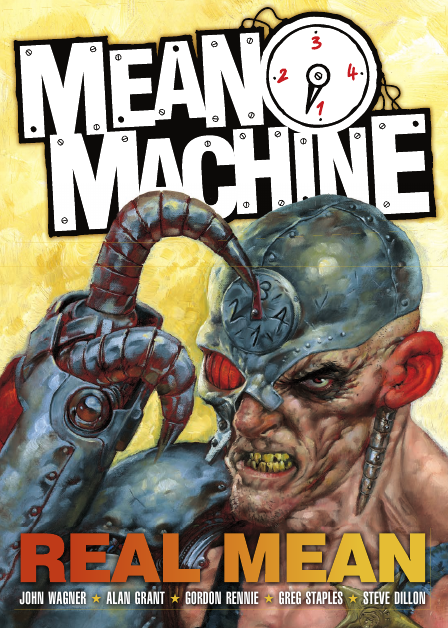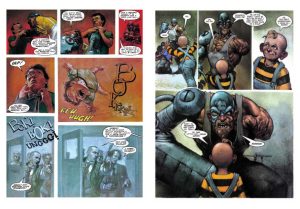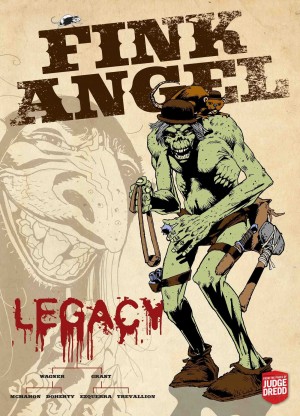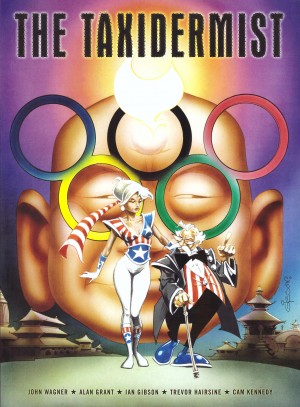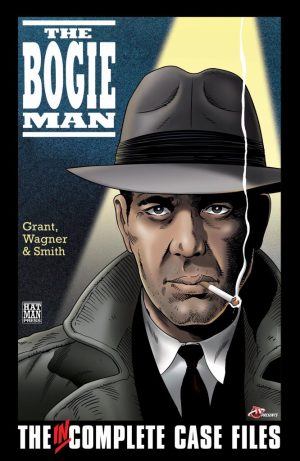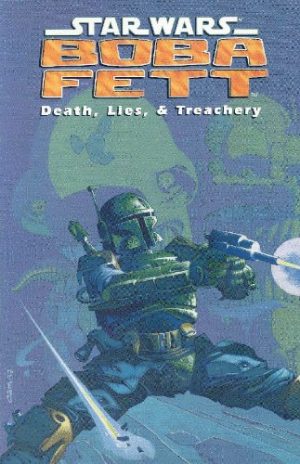Review by Frank Plowright
Mean Machine Angel was an inspired creation from Alan Grant and John Wagner, with Ron Smith responsible for the dim and malevolent thug’s appearance. His arm has been replaced with an awkwardly fused piece of robotic technology, but his crowning glory is a dial with four settings on his forehead connected to his brain and controlling his level of rage. He’s scary enough honing in for a headbutt on 1, and stuck on 4 he can be uncontrollable.
These solo stories span 1995 to 2004 when he’d been long established as a popular antagonist for Judge Dredd, and it’s Wagner who writes the three longest stories. Their beginnings follow a pattern of Mean seemingly tamed and/or rehabilitated, but with Wagner’s knowing wink to the audience that it won’t be long before everything goes pear shaped. Richard Dolan’s art opens the selection with a psychiatrist convinced he can rehabilitate Mean as Wagner almost makes Mean a figure of sympathy taunted by students in his cleaning job, but as Dolan’s glorious sample art shows, it doesn’t take long for normal service to be resumed. The maguffin is a time machine and Mean returning to his past. Each of the Three Stooges given a role is further indication as to the chaos that results.
Good though he is, Dolan’s art is comparatively tame compared to the remaining painters where exaggeration is actively encouraged. Carl Critchlow is the best of them, as seen on the sample art of Mean getting a surprise set to 4. Wagner’s plot has him trying to teach a kid to be bad, which is surprisingly good. As drawn by David Millgate with a healthy Kevin O’Neil influence, Mean is visited by a young woman convinced she can bring out his better nature. Wagner incorporates the hilarious Cyborg Club, but plots himself into a corner that’s only ever going to result in a weak ending.
Both stories by Gordon Rennie are single chapters illustrated in black and white. Kev Walker’s known for painted art, but his black and white storytelling is equally effective on a slim tale of Mean encountering a group of pacifists. The primary purpose is to return him to the Cursed Earth, but when next seen he’s been captured and caged by a travelling show. Paul Marshall’s art is unconvincing, although his characters are well designed, but while working to Wagner’s template of the inevitable explosion, it’s going through the motions.
The collection ends with Wagner and Grant’s 1985 Christmas tale of a supposedly rehabilitated Mean joining an ordinary family for Christmas. Some great funny moments are well extrapolated by Steve Dillon, and it ends with the writers more explicit than usual in underlining what bastards the Judges are.
This collection dips in places, but overall it’s a solid reminder of both what a good character Mean is when well used, and what a great comedy writer Wagner is.
